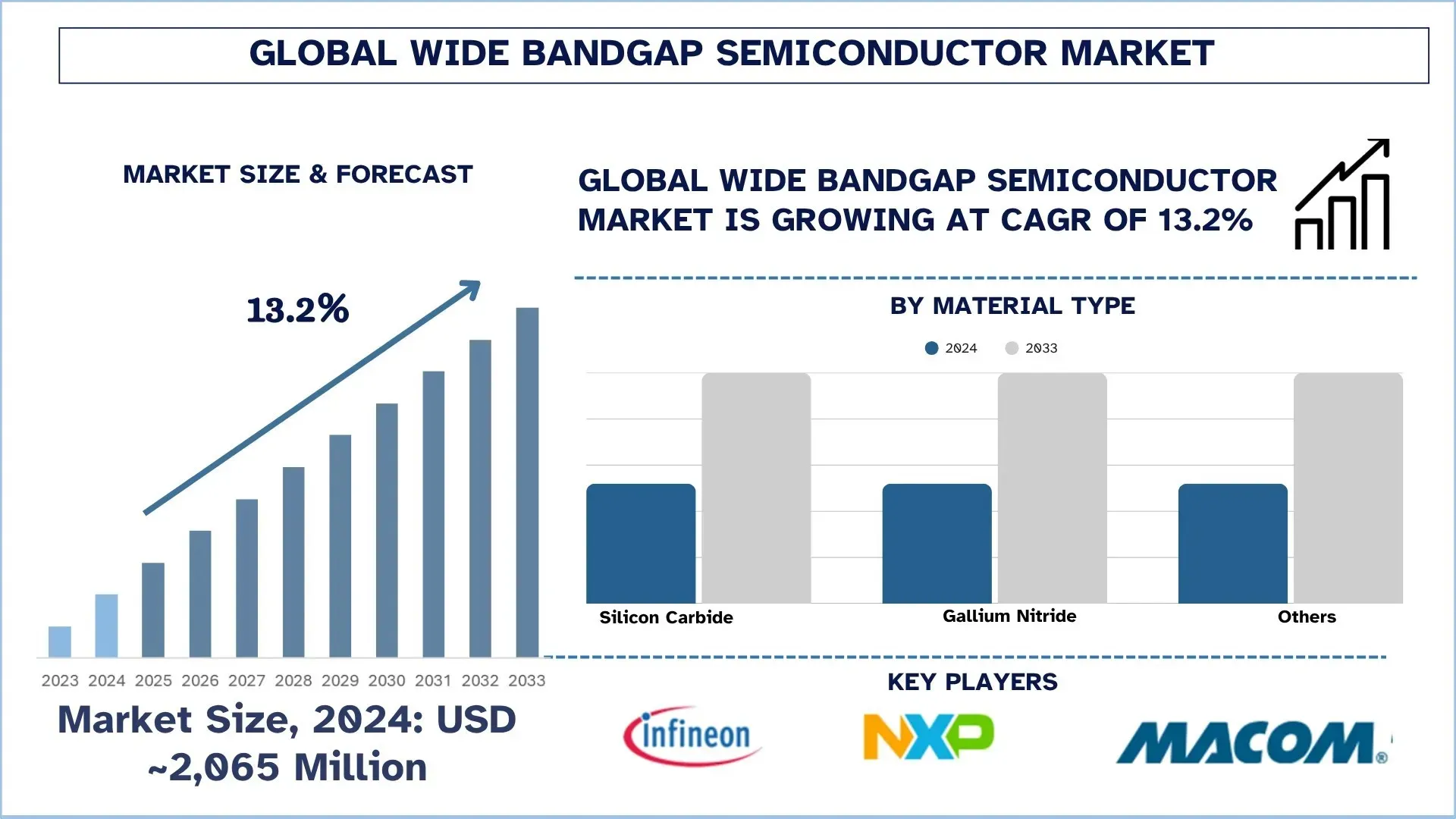- Home
- About Us
- Industry
- Services
- Reading
- Contact Us
Wide Bandgap Semiconductors Market: Current Analysis and Forecast (2025-2033)
Emphasis On Material Type (Silicon Carbide, Gallium Nitride, Others), By Device Type (Power Devices, RF Devices, Optoelectronics), By End-Use (Automotive, Consumer Electronics, Telecommunications, Aerospace & Defense, Energy & Power, and Others) and Region/Country

Global Wide Bandgap Semiconductors Market Size & Forecast
The global Wide Bandgap Semiconductors market was valued at USD 2,065 million in 2024 and is expected to grow to a strong CAGR of around 13.2% during the forecast period (2025-2033F), owing to the rising application in consumer goods and automotive industries.
Wide Bandgap Semiconductors Market Analysis
The WBG Semiconductors Market has seen notable growth with the ability to enhance efficiency, performance, and power handling in a large number of end-user industries. Additionally, the transition to high-efficiency systems in end-user industries such as automotive, consumer electronics, industrial automation, as well as telecommunication sectors has assisted rapid adoption. WBG materials like Silicon Carbide (SiC) and Gallium Nitride (GaN) support higher voltages, temperatures, and frequencies than conventional silicon-based semiconductors do, thus enabling functionalities such as real-time 3D imaging, depth sensing, and precision control. This helps in enabling applications such as facial recognition, gesture control, environmental mapping, and LIDAR in autonomous vehicles, which are among the major demand givers. WBG semiconductors are proving their worth in the next generation design as the industry moves on shrinking and performance efficiency fronts.
Global Wide Bandgap Semiconductors Market Trends
This section discusses the key market trends that are influencing the various segments of the global Wide Bandgap Semiconductors market, as found by our team of research experts.
Miniaturization of Electronic Components:
The miniaturization of electronics being demanded in modern times is a big trend that is shaping the wide bandgap semiconductor market. In consumer electronics, automotive, and aerospace applications, industries demand smaller, lighter, more energy-friendly devices. Thus, WBG materials such as SiC and GaN are given greater importance. They allow for higher power density and may work well at high frequencies and temperatures, allowing passive components and heat sinks to be downsized.
Miniaturization is essential where space is limited, such as in mobile devices, wearable technology, and electric vehicles, where performance cannot be compromised by size or efficiency. WBG semiconductors achieve this through minimization of power losses and good thermal management, enabling compact, reliable, and long-lasting systems. With the continuous adoption of sleek and lightweight technologies in product design, WBG semiconductors shall further help bring change to high-performance electronics.
Wide Bandgap Semiconductors Industry Segmentation:
This section provides an analysis of the key trends in each segment of the global Wide Bandgap Semiconductors market report, along with forecasts at the global, regional, and country levels for 2025-2033.
The Silicon Carbide Category has shown promising growth in the Wide Bandgap Semiconductors Market.
Based on Material Type, the global wide bandgap semiconductors market is segmented into Silicon Carbide, Gallium Nitride, and others. Of these, the Silicon Carbide category has held a sizeable market share. Silicon Carbide holds a large market share due to its much better quality of performance, including high thermal conductivity, higher energy efficiency, and being able to operate at elevated voltages and high temperatures. Considering this, the wide bandgap semiconductors are being extensively demanded for electric vehicles and industrial systems. The demand for SiC-based semiconductors across various prominent global markets is further increased by the increasing adoption of electric vehicles and focus on energy-efficient technologies.
Power Devices Category Dominates the Wide Bandgap Semiconductors Market.
Based on Device Type, the market is segmented into power devices, RF devices, and Optoelectronics devices. These power devices have held a sizeable market share. Some of the factors attributed to the growth are higher demand from power transmission and electric vehicles. As wide bandgap semiconductors offer better protection against power as well as temperature changes, a large number of automobile manufacturers are opting for the WBG semiconductors for their electric vehicle applications, making their market share on the higher side.

North America is expected to grow at a considerable rate during the forecast period.
North America is leading the way owing to heavy demand from electric vehicles, renewable energy systems, industrial automation, and advanced consumer electronics. Innovation in this domain is spurred by the U.S for the Wide Bandgap Semiconductors.
Rapid WBG integration is taking place in the automotive and aerospace sectors in the region, which are mature industries. For instance, WBG materials such as silicon carbide (SiC) and gallium nitride (GaN) are finding extensive use in power electronics systems for inverters, onboard chargers, and advanced driver assistance systems (ADAS), owing to the industries that require very high-performance specifications. These materials find some advantages in terms of their ability to sustain higher temperatures, higher switching speeds, and higher power density, thus making them suitable for applications with extreme performance requirements.
WBG-related technologies in industries are being utilized for precision control, real-time monitoring, and intelligent manufacturing. Also, telecom infrastructure is being improved with GaN-based solutions for 5G base stations and satellite communications.
The US is expected to grow at a considerable rate during the forecast period.
The United States has held a sizeable share in the wide bandgap semiconductor market owing to the developments with a robust innovation ecosystem in place, serving the demands of electric vehicles, defense, renewable energy, and telecommunications. U.S.-based companies are now engaged in the aggressive development of state-of-the-art SiC and GaN technologies so as to realize faster, more efficient power devices with thermal robustness, balancing the heat dissipation characteristics. These activities grew under the flow of ample government support for encouraging domestic semiconductor manufacturing; a few fabrication facilities were created, and the localization of the supply chain gained ground. Also, strategically collaborating with industry and research interests sparks some breakthroughs in material science and design to ensure U.S. superiority in the evolution of WBG semiconductors.

Wide Bandgap Semiconductors Industry Competitive Landscape:
The global Wide Bandgap Semiconductors market is competitive, with several global and international market players. The key players are adopting different growth strategies to enhance their market presence, such as partnerships, agreements, collaborations, new product launches, geographical expansions, and mergers and acquisitions.
Top Wide Bandgap Semiconductor Companies
Some of the major players in the market are Infineon Technologies AG, STMicroelectronics, NXP Semiconductors, ROHM Co., Ltd., MACOM Technology Solutions, Toshiba Electronic Devices & Storage Corporation, Mitsubishi Electric, Navitas Semiconductor, Vishay Intertechnology Inc., and Nexperia.
Recent Developments in the Wide Bandgap Semiconductors Market
For instance, in 2024, RTX announced the development of ultra-wide bandgap semiconductors based on diamond and aluminum nitride technology that offers increased power delivery and thermal management in sensors and other applications.
Global Wide Bandgap Semiconductors Market Report Coverage
Report Attribute | Details |
Base year | 2024 |
Forecast period | 2025-2033 |
Growth momentum | Accelerate at a CAGR of 13.2% |
Market size 2024 | USD 2,065 Million |
Regional analysis | North America, Europe, APAC, Rest of the World |
Major contributing region | North America is expected to dominate the market during the forecast period. |
Key countries covered | U.S., Canada, Germany, U.K., Spain, Italy, France, China, Japan, South Korea, and India |
Companies profiled | Infineon Technologies AG, STMicroelectronics, NXP Semiconductors, ROHM Co., Ltd., MACOM Technology Solutions, Toshiba Electronic Devices & Storage Corporation, Mitsubishi Electric, Navitas Semiconductor, Vishay Intertechnology Inc., and Nexperia. |
Report Scope | Market Trends, Drivers, and Restraints; Revenue Estimation and Forecast; Segmentation Analysis; Demand and Supply Side Analysis; Competitive Landscape; Company Profiling |
Segments Covered | by Material Type, by Device Type, by End-User, by Region/Country |
Reasons to Buy the Wide Bandgap Semiconductors Market Report:
The study includes market sizing and forecasting analysis confirmed by authenticated key industry experts.
The report briefly reviews overall industry performance at a glance.
The report covers an in-depth analysis of prominent industry peers, primarily focusing on key business financials, type portfolios, expansion strategies, and recent developments.
Detailed examination of drivers, restraints, key trends, and opportunities prevailing in the industry.
The study comprehensively covers the market across different segments.
Deep dive regional-level analysis of the industry.
Customization Options:
The global Wide Bandgap Semiconductors market can further be customized as per the requirements or any other market segment. Besides this, UnivDatos understands that you may have your own business needs; hence, feel free to contact us to get a report that completely suits your requirements.
Table of Content
Research Methodology for the Global Wide Bandgap Semiconductors Market Analysis (2023-2033)
We analyzed the historical market, estimated the current market, and forecasted the future market of the global Wide Bandgap Semiconductors market to assess its application in major regions worldwide. We conducted exhaustive secondary research to gather historical market data and estimate the current market size. To validate these insights, we carefully reviewed numerous findings and assumptions. Additionally, we conducted in-depth primary interviews with industry experts across the Wide Bandgap Semiconductors value chain. After validating market figures through these interviews, we used both top-down and bottom-up approaches to forecast the overall market size. We then employed market breakdown and data triangulation methods to estimate and analyze the market size of industry segments and sub-segments.
Market Engineering
We employed the data triangulation technique to finalize the overall market estimation and derive precise statistical numbers for each segment and sub-segment of the global Wide Bandgap Semiconductors market. We split the data into several segments and sub-segments by analyzing various parameters and trends, by Material Type, by Device Type, by End-User, and by regions within the global Wide Bandgap Semiconductors market.
The Main Objective of the Global Wide Bandgap Semiconductors Market Study
The study identifies current and future trends in the global Wide Bandgap Semiconductors market, providing strategic insights for investors. It highlights regional market attractiveness, enabling industry participants to tap into untapped markets and gain a first-mover advantage. Other quantitative goals of the studies include:
Market Size Analysis: Assess the current forecast and market size of the global Wide Bandgap Semiconductors market and its segments in terms of value (USD).
Wide Bandgap Semiconductors Market Segmentation: Segments in the study include areas by Material Type, by Device Type, by End-User, and by
Regulatory Framework & Value Chain Analysis: Examine the regulatory framework, value chain, customer behavior, and competitive landscape of the Wide Bandgap Semiconductors industry.
Regional Analysis: Conduct a detailed regional analysis for key areas such as Asia Pacific, Europe, North America, and the Rest of the World.
Company Profiles & Growth Strategies: Company profiles of the Wide Bandgap Semiconductors market and the growth strategies adopted by the market players to sustain in the fast-growing market.
Frequently Asked Questions FAQs
Q1: What is the global Wide Bandgap Semiconductors market’s current market size and growth potential?
The global Wide Bandgap Semiconductors market was valued at USD 2,065 Million in 2024 and is expected to grow at a CAGR of 13.2% during the forecast period (2025-2033).
Q2: Which segment has the largest share of the global Wide Bandgap Semiconductors market by Material Type?
The Silicon Carbide segment led the market in 2024. Silicon Carbide holds a large market share due to its much better quality of performance, including high thermal conductivity, higher energy efficiency, and being able to operate at elevated voltages and high temperatures.
Q3: What are the driving factors for the growth of the global Wide Bandgap Semiconductors market?
• Renewable Energy Integration: The adoption of wide-bandgap semiconductor technology has been heavily promoted in green energy applications. Due to their excellent properties to work under high voltages and high temperatures with increased efficiency, SiC and GaN are progressively employed in solar inverters and wind turbines. Being fast switchers, they lessen energy losses and bring about compact and reliable energy systems.
• Advancements in Power Electronics: Recent innovations in power electronics have empowered wide-bandgap semiconductor applications in the automotive, aerospace, and industrial sectors. Such semiconductors can provide high power density, low heat dissipation, and smaller system size attributes needed by the compact size of modern electronic devices.
Q4: What are the emerging technologies and trends in the global Wide Bandgap Semiconductors market?
• Expansion in Automotive Applications: The automotive industry finds itself increasingly incorporating Wide Bandgap Semiconductors with the view of enhancing safety, automation, and in-cabin user experience. These sensors have found application in ADAS, primarily for object detection, pedestrian recognition, and environmental mapping-around the prerequisite for semi- and fully autonomous vehicles.
• Growth in Wearable Technology: The rapid growth of wearable technology is pushing the demand for Wide Bandgap Semiconductors. Nowadays, 3D sensing is placed into smartwatches, fitness trackers, and even AR glasses for a better user interaction or to provide some new functionality.
Q5: Which region dominates the global Wide Bandgap Semiconductors market?
The North America region dominates the global Wide Bandgap Semiconductors market due to the rising demand for automobiles, manufacturing, and consumer goods segments.
Q6: Who are the key players in the global Wide Bandgap Semiconductors market?
Some of the top Wide Bandgap Semiconductors companies include:
• Infineon Technologies AG
• STMicroelectronics
• NXP Semiconductors
• ROHM Co., Ltd.
• MACOM Technology Solutions
• Toshiba Electronic Devices & Storage Corporation
• Mitsubishi Electric
• Navitas Semiconductor
• Vishay Intertechnology Inc.
• Nexperia
Q7: What are the opportunities for companies within the Global Wide Bandgap Semiconductors market?
Companies have significant opportunities in sectors undergoing electrification and digital transformation, such as electric vehicles, renewable energy, and 5G infrastructure. By developing high-efficiency, thermally robust SiC and GaN-based solutions, they can meet the rising demand for compact and energy-saving power electronics. There’s also strong potential in industrial automation, aerospace, and smart grid applications. Collaborating with OEMs to deliver application-specific solutions and targeting emerging markets with reliable, cost-effective WBG components can unlock new revenue streams and long-term growth.
Q8: How can stakeholders navigate technological advancements in the Wide Bandgap Semiconductors market?
Stakeholders should prioritize innovation through continuous R&D in SiC and GaN materials, focusing on improving performance, reliability, and cost-efficiency. Keeping pace with advancements in electric mobility, AI-driven control systems, and high-frequency power devices is essential. Strategic partnerships with research institutions, OEMs, and foundries can accelerate technology adoption.
Related Reports
Customers who bought this item also bought









